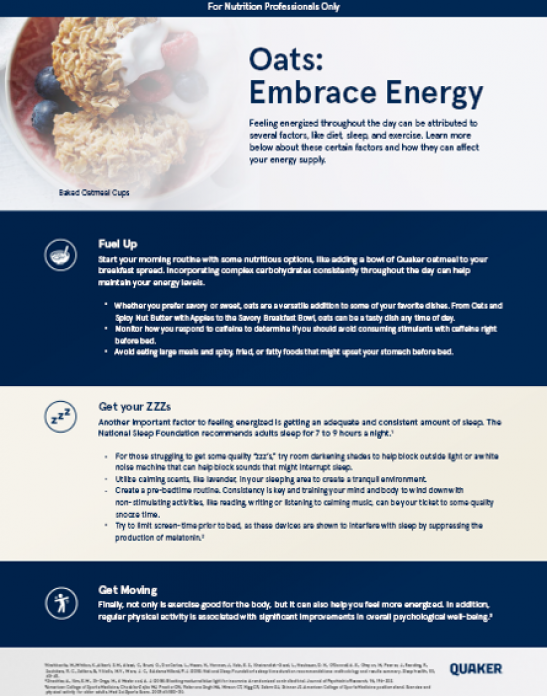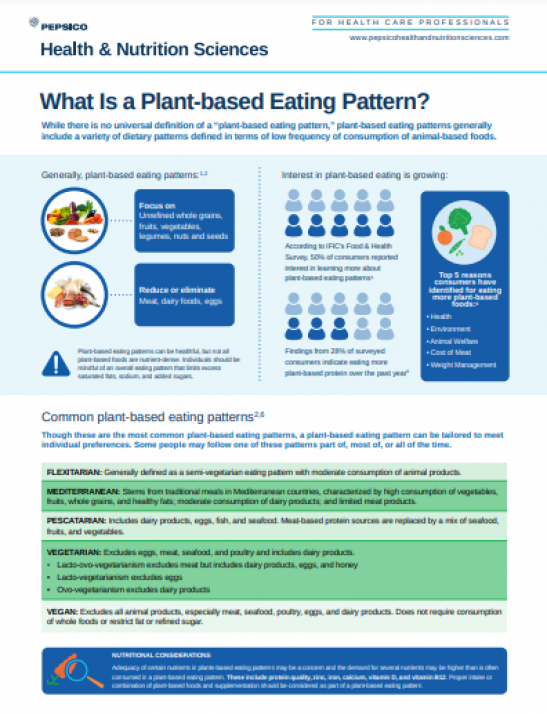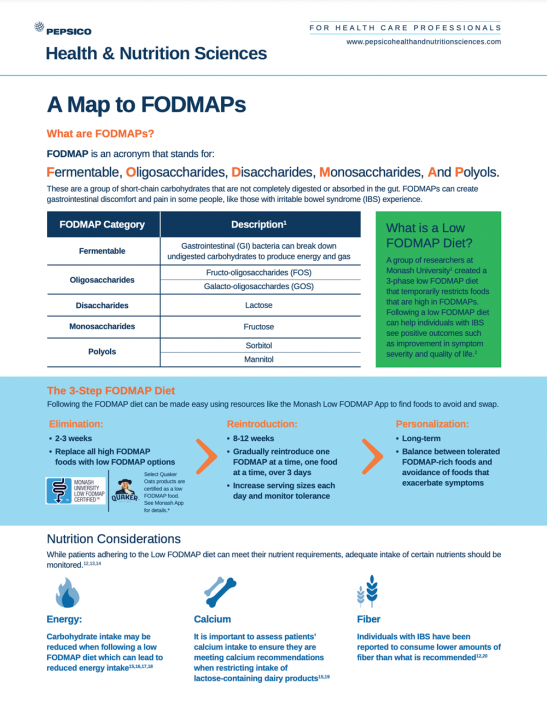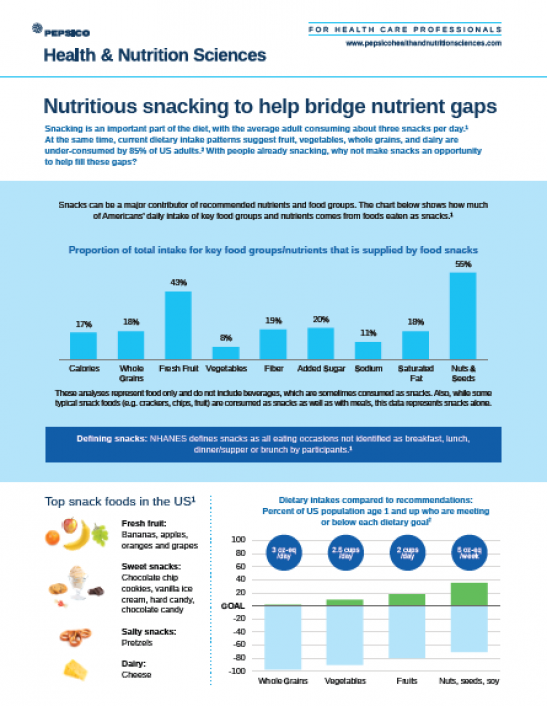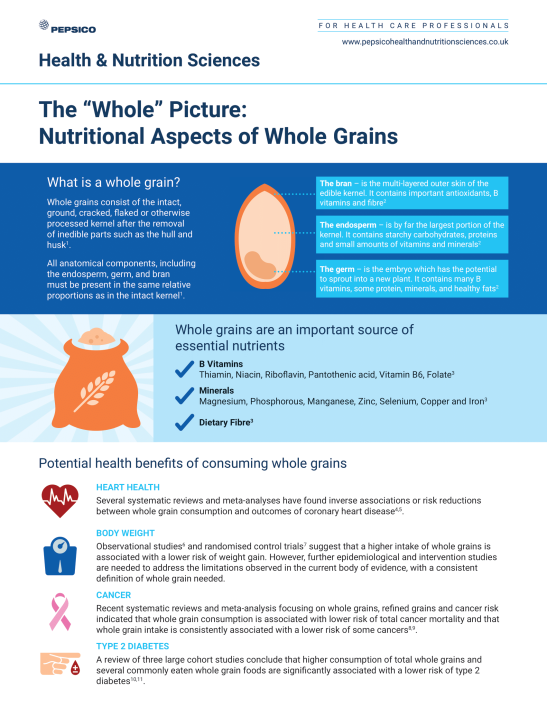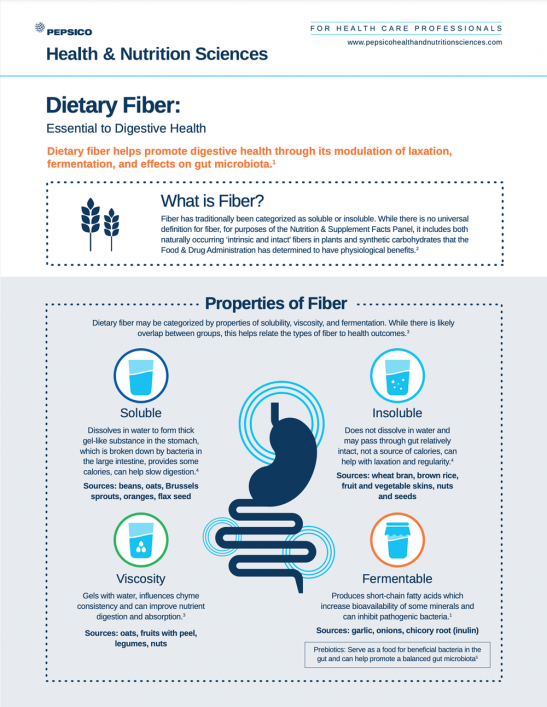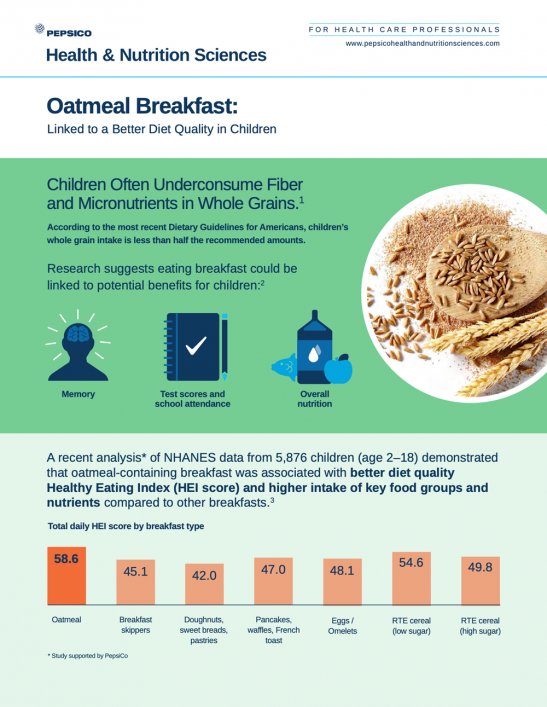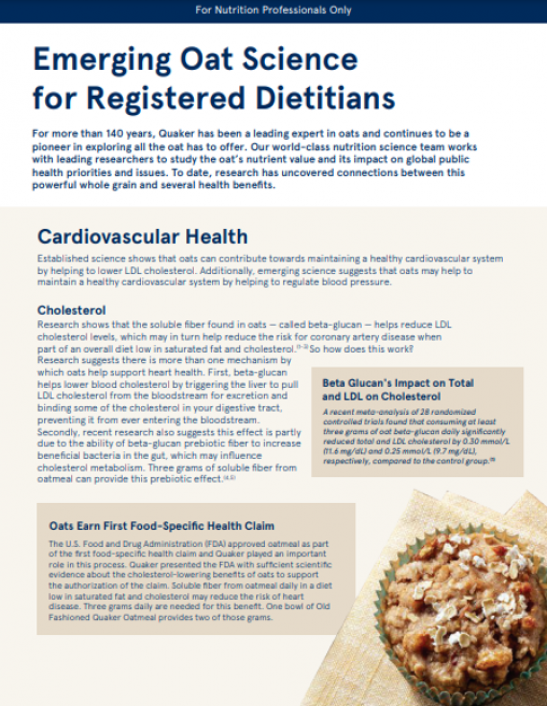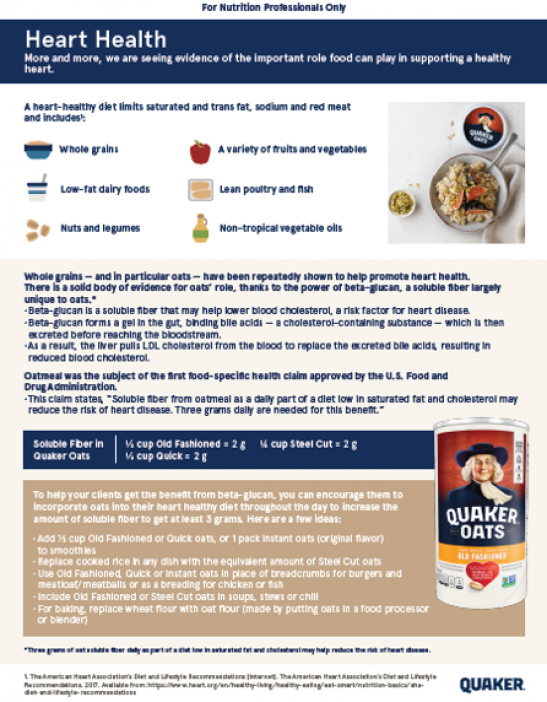- Factors that can effect energy supply
- Oats as a source of energy
- Common plant-based eating patterns
- Potential health benefits associated with eating plant-based foods
- What prebiotics are and how they work
- Types and sources of prebiotics
- What FODMAPs are and food sources
- The low FODMAP diet
- Role of FODMAPs in IBS symptoms
- Contribution of snacks toward food groups & nutrients
- Snack ideas
- The structure of a whole grain.
- Nutrition and potential health benefits of consuming whole grains.
- Whole grain recommendations and sources.
- Fiber and digestive health
- Properties of fiber
- Sources of fiber
- Oatmeal & diet quality
- Whole grains
- High blood pressure is a major risk factor for heart disease and death
- Wholegrains like Oats and dietary fibers in a healthy diet can help lower blood pressure
- Bioactives in Oats can normalize pathways involved in the maintenance of a healthy blood pressure
- Connection between oats and potential health benefits
- Oats & heart health
- Heart healthy recipes
- How to make Apple Sheet Pan Pancakes
- How to make Chili-Lime Crunch Salad
- Whole grains & nutrition
- Potential health benefits of consuming whole grains
Pasman, W. J., Hendriks, H. F. J., Minekus, M. M., de Ligt, R. A. F., . . . Bellmann, S. (2018). Subjective feelings of appetite of wholegrain breakfasts evaluated under controlled, laboratory and ‘at home’ conditions. Physiology and Behavior, 194, 285-291. doi:10.1016/j.physbeh.2018.06.024
Abstract
Background: Appetite regulating properties of foods are usually investigated under laboratory conditions, whereas in real life, foods are consumed under at home conditions. The objective of this study was to compare the acute effects of breakfasts when tested in a laboratory condition and in an at home condition. Appetite regulating properties of two bread breakfasts and two cereal breakfasts were also compared. Subjects and methods: In this randomized cross-over trial balanced for laboratory and at home test conditions, thirty-two women consumed five breakfasts, i.e. two bread breakfasts, two cereal breakfasts and one fried-egg breakfast. Visual analogue scales for measuring appetite were captured via an on-line scoring system and were analyzed as incremental area under the curve, as satiation phase and as satiety phase. Results: Location effects were limited to two small effects only. An overall location effect in hunger feelings was observed (p = 0.040), which occurred specifically during the short satiation period (p = 0.0002) where hunger feelings scored higher under laboratory conditions. Similarly, a location effect was observed for desire to eat (p = 0.001); this was again higher under laboratory conditions. No other location effects were observed. Bread breakfasts did not differ in their appetite regulating properties. The Steel Cut oatmeal breakfast was reported to be more satiating (p = 0.001) as compared to the ready-to-eat cereal. Conclusions: Whereas the five breakfasts varied somewhat in their appetite regulating properties, evaluation under laboratory conditions overall did not result in different appetite scores compared to the at home conditions. This suggests that at home testing may be a useful alternative to laboratory test conditions for nutrition research.
Taylor, J. R. N., Rehm, C. D., L. de Kock, H., Donoghue, S., Johnson, A., Thompson, C., & Berezhnaya, Y. (2023). South African Consumers’ Knowledge, Opinions and Awareness of Whole Grains and Their Health Benefits: A Cross-Sectional Online Survey. Nutrients, 15(16), 3522. doi.org/10.3390/nu15163522
Abstract
Evidence indicates that whole-grain food consumption reduces the risk of cardiovascular disease, type-2 diabetes, and some cancers. Increasing whole-grain consumption in developing countries is likely to significantly benefit the health of the population. However, there is very limited information on consumer whole-grain knowledge, attitudes, and behaviors in developing countries. An online cross-sectional survey was conducted among 1000 South African consumers with sufficient income to make food purchase choices and who were generally representative in terms of gender, age, and ethnicity. Most respondents (64%) were confident of their whole-grain knowledge. However, 60% of all participants selected incorrect definitions of whole grains. Whilst most correctly identified common cereals as whole grains, at most 50% of participants correctly identified common whole-grain foods. Also, whilst most (67%) thought that they were consuming enough whole grains, the majority (62%) underestimated the recommended level of consumption. Furthermore, respondent knowledge regarding whole-grain food attributes and the health benefits of whole-grain consumption was generally poor. Clearly, consumer-focused strategies are needed in developing countries to increase whole-grain food consumption to help the broader population achieve a healthy and sustainable diet. Actions proposed include: simple-to-understand information on whole-grain content relative to recommendations on food product labels, the provision of whole-grain foods in school nutrition schemes, and coordinated social and behavior change communication initiatives.
Rao, E. S., Yadav, R., Rizwana, Lalmuanpuia, C., . . . Meena, P. M. (2022). Impact of nutrition education on whole grains consumption amongst primary and middle school children in Delhi. Food Science and Technology, 10(2), 23 – 33. doi:10.13189/fst.2022.100202
Abstract:
Imparting nutrition education in schools is an effective tool for inculcating healthy eating behavior in early childhood, which will bestow lifelong positive health implications. Ignorance, illiteracy, lack of nutrition knowledge, and inappropriate nutritional practices and dietary traditions influence the nutritional status of children. This study assesses the existing knowledge, attitude, and practices prevalent amongst the school children (6-14 years) in the consumption of whole grains and examines the impact of nutritional intervention on them. 22% of participants were from primary school in the age group of 6-10 years, and 78% were from middle school between the ages of 11-14 years. Total percentage of girl students was 84% against boys, which was 16%. Nutrition education was imparted to the school children through visual presentation on the importance of consuming whole grains, structure and composition of whole grains, difference between refined and whole grains, food sources, nutritional importance, rich sources of dietary and soluble fibre, besides promoting digestive health and wellness. Self-designed fun nutrition games and food quizzes were employed to engage with the school students. In the pre-assessment survey, the middle school students showed significantly (p≤0.05) higher knowledge than primary school students. Although after implementing the nutrition education program in the post-assessment survey, an increase in knowledge about whole grains was observed both in primary as well as middle school students. However, no significant difference was seen in the knowledge acquisition between male and female students in pre or post-nutrition intervention assessment. The present study showed an incremental rise in the knowledge and attitude of primary and secondary school children in the age group of 6-14 years in all aspects of whole-grain education. Therefore, this intervention showed that in order to bridge the gap of nutrition literacy among school-going children, integrating nutrition education into the school curriculum can be an effective tool for inculcating healthy eating behavior in early childhood.
Madan, J., Hussain, N., Joshi, S., Mehra, J., . . . Thomas, J. (2021). Understanding whole grain awareness and consumption in select Indian cohorts. Journal Indian Medical Association, 119(1), 88-94.
Abstract:
Background and Introduction: Grains are an integral part of Indian diet. Carbohydrates constitute to 60-70% of total daily calorie intake and grains are the key carbohydrate source. Including whole grains(WG) in the diet for its health benefits is recommended in dietary guidance around the world. There is consistent evidence to support existence of barriers to WG consumption in Indian population but limited evidence assessing their level of awareness and knowledge on WG. Thus, an independent survey was designed for assessing the level of awareness and consumption of WG amongst millennials and nutritionist and dieticians. Data collection and analysis: Tool employed was self-developed questionnaire. SPSS software and MS Excel were used for analysing data. Results: Only 2% of the surveyed millennials were aware of all aspects of WG. Nutritionists and dieticians showed better responses than millennials. Daily WG consumption in millennials was less than 10% (42 g/day) compared to total grain consumption (432g/day) across food categories. 50% nutritionists and dieticians consume oats for breakfast. Conclusion: Results highlight the importance of raising awareness on the knowledge and consumption of WG amongst urban Indian millennials. It also emphasises the need of national recommendations, encouraging consumers to make half of their total grain consumption as WG. A WG stamp from FSSAI for identification of products with considerable amount of WG and campaigns with public-private partnership supported by nutritionist, dietitians, culinary experts can further help in attaining the goal of a WG rich “Sustainable Healthy Diet” for a healthy living
Fulgoni, V. L., Brauchla, M., Fleige, L., & Chu, Y. (2020). Association of whole-grain and dietary fiber intake with cardiometabolic risk in children and adolescents. Nutrition and Health, 26(3), 243-251. doi:10.1177/0260106020928664
Abstract:
Background: Diet is known to affect many risk factors of cardiovascular disease (CVD), a leading cause of mortality and morbidity. Aim: The objective of this study was to explore the potential association between whole grain and dietary fiber with CVD risk factors, including metabolic syndrome (MetS) in children and adolescents using National Health and Nutrition Examination Survey (NHANES) 2003–2014. Methods: Two days of 24-hour recall data from 16,507 children and adolescents age 2–18 years were used to estimate dietary intakes. Continuous MetS scores (cMetS) were computed by aggregating age/sex regressed z-scores of waist circumference, mean arterial blood pressure, high-density lipoprotein-cholesterol, triglycerides, and glucose. Regression analyses were used to assess association of fiber and whole grain intake with cardiometabolic markers including MetS after adjusting for demographic factors. Results: Increasing tertiles of fiber intake were significantly associated with 3% lowered risk MetS in adolescents age 13–18 years. Additionally, increasing intake tertiles of fiber were associated with reduced risk elevated cholesterol (5–11% reduction), elevated diastolic blood pressure (10–23% reduction) in adolescents age 13–18 years, and risk of obesity (3–5% reduction) in children and adolescent age 2–18 years. Increasing tertiles of whole grain intake were only associated with reduced risk of elevated triglycerides (52% risk reduction) in adolescents age 13–18 years. Conclusion: The results suggest that intake of dietary fiber was inversely associated with several markers of cardiovascular disease risk including MetS.
Sang S., Idehen E., Zhao Y., & Chu Y. (2020). Emerging science on whole grain intake and inflammation. Nutrition Reviews, 71(S1), 21-28. doi: 10.1093/nutrit/nuz079
Abstract:
Although the biological mechanisms surrounding the widely reported association between whole grain (WG) consumption and reduced risk of several diseases are not fully understood, there is growing evidence suggesting that inflammation may be an essential mediator in this multifaceted process. It also appears that several mechanisms influence the modulatory actions of WGs on inflammation, including the effect of fiber, phytochemicals, and their microbial-derived metabolites. While some of these effects are direct, others involve gut microbiota, which transform important bioactive substances into more useful metabolites that moderate inflammatory signaling pathways. This review evaluates emerging evidence of the relationship between WGs and their effects on markers of subclinical inflammation, and highlights the role of fiber, unique WG phytochemicals, and gut microbiota on the anti-inflammatory effects of WG intake.
Mathews, R., & Chu, Y. (2020). Global review of whole grain definitions and health claims. Nutrition Reviews, 78(S1), 98-106. doi:10.1093/nutrit/nuz055
Abstract:
Recommendations to increase whole grain consumption are part of dietary guidelines around the world. To assist consumers in meeting this recommendation, some countries, and health-promoting organizations, have defined qualifying criteria for a whole grain food for product labeling or health claims. Other countries have not yet developed similar guidelines. Existing whole grain definitions and health claims are reviewed here. While there appears to be increasing consensus for defining a whole grain, significant disparity exists in defining a whole grain food when a product is not 100% whole grain. Moreover, while whole grain health claims have been approved in a few countries, other countries have concluded there is insufficient evidence to substantiate such claims.
Sang, S., & Chu, Y. (2017). Whole grain oats, more than just a fiber: Role of unique phytochemicals. Molecular Nutrition and Food Research, 61(7), 10.1002/mnfr.201600715. doi:10.1002/mnfr.201600715
Abstract:
Oats are a good source of soluble dietary fiber, especially β-glucan, which has outstanding functional and nutritional properties. β-Glucan is considered to be the major active component of oats because of its cholesterol-lowering and antidiabetic effects. However, the nutritional benefits of oats appear to go beyond fiber to bioactive phytochemicals with strong antioxidant and anti-inflammatory effects. In this review, we summarize current knowledge on the chemistry, stability, bioavailability, and health effects of two unique phytochemicals in oats, avenanthramides, and avenacosides A and B. We conclude that studies on the beneficial effects of avenanthramides and avenacosides A and B are still in their infancy, and additional health benefits of these unique oat components may yet be identified.
Shi, Y., Johnson, J., O'Shea, M., & Chu, Y. F. (2014). The bioavailability and metabolism of phenolics, a class of antioxidants found in grains. Cereal Foods World, 59(2), 52-58. doi:10.1094/CFW-59-2-0052
Abstract:
Consumption of whole grains has been shown to reduce the risk of chronic diseases. Whole grains contain a variety of bioactive compounds with antioxidant properties that can help prevent disease by inhibiting oxidative damage. The health benefits of whole grains depend not only on the functions of the bioactive compounds they contain, but also on the quantities of those compounds consumed, their metabolism, their bioavailability in different tissues, and the functions of their metabolites in the body. This article provides an overview of grain antioxidants, including their metabolism and bioavailability, with a focus on the phenolics ferulic acid, alk(en)ylresorcinols, and avenanthramides. Ferulic acid is the most abundant form of phenolic acid found in cereal grains; alk(en)ylresorcinols are found in large quantities in rye and wheat; and avenanthramides are found only in oats. Results from in vitro, in vivo, and human studies indicate that all three phenolic compounds have potent antioxidant properties
Korczak, R., Marquart, L., Slavin, J. L., Ringling, K., . . . Unnevehr, L. (2016). Thinking critically about whole-grain definitions: Summary report of an interdisciplinary roundtable discussion at the 2015 Whole Grains Summit. American Journal of Clinical Nutrition, 104(6), 1508-1514. doi:10.3945/ajcn.115.126672
Abstract:
Definitions for whole grain (WG) have been published by governments, the food industry, and grain organizations and generally fall into 2 categories: WG and WG food. WG definitions focus on the principal components of the WGs and their proportions, whereas WG-food definitions describe the quantity of WGs present in food. In the United States, widespread agreement exists on the main parts of a definition for a WG, with a definition for a WG food still in its early stages; a standard definition that has been universally accepted does not exist. Furthermore, nutrition policy advises consumers to eat WGs for at least one-half of their total grain intake (2010 and 2015 Dietary Guidelines for Americans), but confusion exists over which foods are considered WGs and how much is needed to achieve health benefits. In December 2014, a workshop sponsored by the subcommittee on collaborative process of the US Government’s Interagency Committee on Human Nutrition Research convened in Washington, DC, and recognized WG definitions as a key nutrition and public health–related issue that could benefit from further collaboration. As a follow-up to that meeting, an interdisciplinary roundtable meeting was organized at the Whole Grains Summit on 25 June 2015 in Portland, Oregon, to help resolve the issue. This article summarizes the main opportunities and challenges that were identified during the meeting for defining WGs and WG foods internationally. Definitions of WGs and WG foods that are uniformly adopted by research, food industry, consumer, and public health communities are needed to enable comparison of research results across populations.
Clemens, R., & Van Klinken, B. J. (2014). Oats, more than just a whole grain: An introduction. British Journal of Nutrition, 112, S1-S3. doi:10.1017/S0007114514002712
Abstract:
In May 2012, an oats workshop was held in New York to convene a group of international experts to discuss the implications and applications of oats relative to human health. These diverse experts represented disciplines including, but not limited to, epidemiology, food regulation, nutrition and food science, grain breeding and plant genetics, food processing, medicine and public-health policy. This ensuing series addresses three important aspects pertinent to oats: a brief overview of the dynamics of oats; the spectrum of established and emerging research in agriculture and health; and the options and opportunities for future applications of oats that extend beyond dietary fibre. Oats have many unique chemical properties, potential health benefits, agricultural challenges and nutrition-policy opportunities – but global production of oats appears to be falling. This is occurring despite contemporary research in the development of drought and infestation resistance and climate-adaptive cultivars and assessments of oats’ unique components (such as dietary fibre, lipids, β-glucan and avenanthramides) that may contribute to health benefits. This suggests that oats represent a promising grain in the whole-grains landscape. New insights have been created into benefits beyond cardiovascular health. Modern milling and processing technologies have been developed to retain the nutritive value and functional properties of oats and to assure a consistent foundation for global health policies.
McKeown, N. M., Jacques, P. F., Seal, C. J., de Vries, J., . . . Marquart, L. F. (2013). Whole grains and health: From theory to practice-highlights of The Grains for Health Foundations Whole Grains Summit 2012. The Journal of Nutrition, 143(5), 744S-758S. doi:10.3945/jn.112.172536
Abstract:
The Grains for Health Foundations Whole Grains Summit, held May 19–22, 2012 in Minneapolis, was the first meeting of its kind to convene >300 scientists, educators, food technologists, grain breeders, food manufacturers, marketers, health professionals, and regulators from around the world. Its goals were to identify potential avenues for collaborative efforts and formulate new approaches to whole-grains research and health communications that support global public health and business. This paper summarizes some of the challenges and opportunities that researchers and nutrition educators face in expanding the knowledge base on whole grains and health and in translating and disseminating that knowledge to consumers. The consensus of the summit was that effective, long-term, public-private partnerships are needed to reach across the globe and galvanize the whole-grains community to collaborate effectively in translating whole-grains science into strategies that increase the availability and affordability of more healthful, grain-based food products. A prerequisite of that is the need to build trust among diverse multidisciplinary professionals involved in the growing, producing, marketing, and regulating of whole-grain products and between the grain and public health communities.
Musa-Veloso, K., Poon, T., Harkness, L. S., O'Shea, M., & Chu, Y. (2018). The effects of whole-grain compared with refined wheat, rice, and rye on the postprandial blood glucose response: A systematic review and meta-analysis of randomized controlled trials. American Journal of Clinical Nutrition, 108(4), 759-774. doi:10.1093/ajcn/nqy112
Abstract:
Background: Whole grains are often referred to collectively, despite differences in their composition, physical structure, processing, and potential health benefits. Objective: The aim of this study was to compare the postprandial blood glucose response of whole-grain with refined wheat, rice, or rye, while controlling for the food delivery matrix and the processing of the grain (e.g., grinding, germination). Design: Eleven electronic databases were systematically searched to identify studies published up to and including November 2017. Randomized controlled trials comparing the effects of whole-grain wheat, rice, or rye with those of each grain's refined counterpart on postprandial blood glucose area under the curve (AUC) were included. Pooled effect sizes were computed by using the difference in the blood glucose AUC after the consumption of the whole compared with the refined grain. Results: Twenty publications were included, with 10, 14, and 5 strata (or active-control comparisons) on whole-grain wheat, rice, and rye, respectively. The consumption of ground (wholemeal) wheat, compared with white wheat, was not associated with a significant reduction in blood glucose AUC (−6.7 mmol/L ⋅ min; 95% CI: −25.1, 11.7 mmol/L ⋅ min; P = 0.477). The consumption of wholemeal rye, compared with endosperm rye, was not associated with a significant reduction in blood glucose AUC (−5.5 mmol/L ⋅ min; 95% CI: −24.8, 13.8 mmol/L ⋅ min; P = 0.576). The consumption of intact (whole-grain) rice, compared with white rice, was associated with a significant reduction in blood glucose AUC (−40.5 mmol/L ⋅ min; 95% CI: −59.6, −21.3 mmol/L ⋅ min; P < 0.001). Conclusions: Compared with white rice, whole-grain rice significantly attenuates the postprandial blood glucose response. In most of the studies on wheat and rye, the postprandial blood glucose responses to foods formulated with wholemeal compared with refined flours were compared. Whether reductions in the blood glucose AUC can be achieved with whole-grain (as opposed to wholemeal) wheat and rye requires further investigation.

